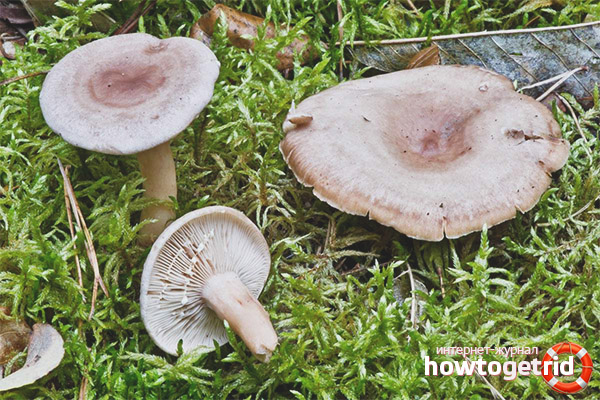The content of the article
Mlechnik faded is part of the Syroezhkov family, the genus Mlenik. It is conditionally edible and is used only for harvesting for the winter. In another form, it is forbidden to use. Other names are also found in the literature, such as a swamp trefoil and a sluggish lactarius.
Characteristic
All features related to this genus are inherent in him. The hat has a convex shape with curved edges. In the process of ripening, it opens and is pressed. The edges become wavy. The diameter of the cap of an adult mushroom reaches a maximum of 8 cm, so the mushroom is considered quite large.
The surface of the fungus is slightly smooth, there is mucus on the cap, which performs a protective function against drying out. Trash and dust sticks to it, which prevails in that area. Inside the hat there are cream-colored plates that drop a little on the leg.
The leg is round, in some cases slight flatness is possible. In addition, depending on the growing conditions, there are even or curved. If in the area where it grows, a large amount of moss predominates, through which the milky milky have to break through, the leg becomes bent.
Inside, it is empty, gradually tapering below. In height, it reaches 8 cm, despite the fact that the diameter will be within 0.5 cm. Not only the hat, but also the leg has a small amount of mucus. In color, it is the same shade as the hat, only a little dimmer.
It differs from its related mushrooms in color. The hat may be mauve or mauve. It depends on the level of maturity and the territory in which it grows. If the street is hot and arid, or the mushroom grows on a sunny spot, it turns pale, becoming almost white. There are times when a faint, barely visible pattern appears on it.
When the fungus is damaged, it releases a caustic white juice, which interacts with oxygen and turns gray.
Places of Growth and Harvest
They prefer to grow in loesses with high humidity, so it is more likely to meet them near marshes and other bodies of water. They also grow in forests where there is a fairly large amount of moss. Moss is able to retain the moisture that mushrooms love.
The taste of the faded milky
This mushroom variety is endowed with an excellent taste that is different from other mushrooms, but you can enjoy it only with the right heat treatment.
The mushroom is odorless, and its flesh is thin and brittle. To taste, it is endowed with bitterness, which can be eliminated after proper processing. The easiest and most successful way - cooking mushrooms. Only after this can you start pickling them for the winter.
Years of experience show that it becomes as delicious as possible after pickling. Before use, the mushrooms are immersed in water so that excess salt leaves them.
Related mushrooms
The main relatives of the faded lactifer can be attributed to:
Common miller
The hat in diameter varies between 8-15 cm. In an unripe state, it has an irregular shape, mucus is present on the surface, the color of young mushrooms is purple-lilac or fawn-brownish. When the mushroom is fully ripe and begins to age, its color changes to pink-brown or yellowish-lilac.
It is also lamellar. His records fall on the yellow leg. Its height is 5-10 cm. It is cylindrical and even in shape. Aging she becomes hollow.
The pulp of an ordinary lactarius is quite strong, white. When damaged, juice is secreted, which after drying takes on an olive-brown color. Spores of the mushroom are elliptical.
Papillary milky
A relatively small mushroom, the diameter of the hat varies between 3–9 cm, it is flat in shape, a tubercle is located in the center, its edges are bent. The color of the hat is gray-brown. Unlike the lactarius faded and ordinary, it does not have mucus on its surface.
The length of the leg is 3-7 cm, in diameter - 1-2 cm, has the shape of a cylinder, smooth, the same color as the hat. The plates are narrow, white. The mushroom pulp is brittle, white and has a mild coconut flavor. Spore powder is gray or white. With mechanical damage to the fungus, it secretes white juice, in a small amount, which interacts with oxygen and becomes dark.
This variety can be found in forests, he prefers sandy soil. Harvesting starts in August and ends in September.
Video: Lactarius faded (Lactarius vietus)











Submit